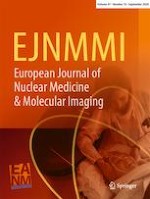05.03.2020 | Short Communication
Prognostic biomarkers in men with metastatic castration-resistant prostate cancer receiving [177Lu]-PSMA-617
Erschienen in: European Journal of Nuclear Medicine and Molecular Imaging | Ausgabe 10/2020
Einloggen, um Zugang zu erhaltenAbstract
Purpose
We analysed quantitative biomarkers derived from both baseline whole-body imaging and blood serum to identify prognostic markers in patients treated within the lutetium-177 prostate-specific membrane antigen (LuPSMA) phase 2 trial.
Methods
PET image analysis was carried out using whole-body segmentation quantifying molecular tumour volume (SUV > 3 threshold for PSMA, SUV > liver+2sd for fluorodeoxyglucose (FDG) including SUVmax and SUVmean. For baseline bone scans, EXINI bone scan index (BSI) was used to calculate the percentage of involved bone. Baseline alkaline phosphatase (ALP), lactate dehydrogenase (LDH), prostate specific antigen (PSA) and PSA doubling time were also used in this analysis. We used univariate cox regression analysis and log-rank comparison with optimised cut-offs to find suitable biomarkers prognostic of overall survival from time of enrolment.
Results
This analysis identified FDG-positive tumour volume (FDGvol; HR 2.6; 95% CI, 1.4–4.8), mean intensity of PSMA-avid tumour uptake (PSMAmean; HR 0.89; 95% CI, 0.8–0.98), bone scan index (BSI; HR 2.3; 95% CI, 1.2–4.4), ALP (HR 1.1; 95% CI, 1–1.2) and LDH (HR 1.2; 95% CI, 1–1.5) as biomarkers prognostic of overall survival.
Conclusions
In addition to established biomarkers, both FDG and PSMA PET/CT parameters have prognostic significance for survival in men undergoing LuPSMA therapy.
Anzeige











